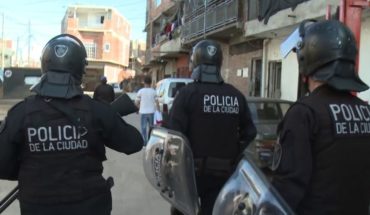
This Saturday, September 5, 2020, Ludmila Pretti went to a party six blocks from her house and didn’t come back. He’ll never stop being 14 anymore. She was found dead on Monday, semi-naked, under a bed. The suspect in his femicide, fugitive from justice, is a 19-year-back. It happened in Francisco Alvarez, Moreno’s party, Buenos Aires province.
Before Ludmila, up to 172 women and girls (and 9 children or men associated with them) had been victims of femicide, as they prefer to call him in Argentina. Another 167 had been spared femicide attempts. And 193 minors had lost their mothers so far this year. All this, until 3 September, according to cross-data from observatories such as the NGOs Mumalá and La Casa del Encuentro, or that of the Ombudsman’s Office.
20% of these women had made complaints, and 10% had some restriction measures, such as the “panic button.” All this, not counting 27 other violent deaths under investigation, which raise the total to 208 violent deaths of cis, trans or transvestite women.
Previously, in 2019, the National Register of Femicides of Justice Argentina (RNFJA) documented 252 femicides. The Meeting House, 299. That is why this June, Clarín, the country’s largest newspaper, published a multi-page obituary with the names of more than 300 women and girls who were victims of femicide. Lots of names. And yet, they weren’t all remotely there.
What has Argentina done against femicides?
“Much progress has been made in Argentina in legislative matters for the protection of women and the LGBTIQ+ community. The work of feminist collectives, both in the theoretical areas and in the territories, and the claims that were made accordingly, were reflected in national and provincial laws, explains to DW Ada Rico, president of the civil association La Casa del Encuentro and director of its Observatory of Femicidios.
Therefore, “Argentina’s regulatory body today on violence against women is a model for several countries in the region,” Rico says, listing: comprehensive protection laws and gender identity; a law for the creation of a body of specialized lawyers; modification of the civil and commercial code with the deprivation of parental responsibility to femicides; gender parity laws in areas of political representation and economic reparation for children and adolescents; the Micaela Act on gender training for public officials, and the recent trans job quota.
Argentina is also part of twenty Latin American and Caribbean countries that criminalized “femicide” or “femicide” as a specific crime in its criminal codes or, in the Argentine case, as a type of aggravated homicide.
The risk of gender-based violence increased during the COVID-19 pandemic.
The country has a free line of care, advice and containment in situations of gender-based violence, 24 hours a day, 365 days a year, by phone (144), WhatsApp (1127716463), email (linea144@mingeneros.gob.ar) or app. It is served by an interdisciplinary team trained in a gender perspective. And it contemplates all types of violence described in the law: physical, psychological, sexual, economic and heritage, symbolic, political, domestic, institutional, labor, against reproductive, obstetric, media and public space freedom.
In Argentina, five years ago, the “Not one less” movement emerged, pioneering the fight against sexist violence in Latin America. And, since December, the country has a Ministry of Women, Gender and Diversity. Her minister, Elizabeth Gómez Alcorta, is a feminist human rights lawyer and academic. In early July, she presented a “National Plan of Action against Gender-Based Violence (2020-2022)”, especially against femicides, “stablely high” years ago, the minister recalled.
The Plan puts the fight against machismo at a priority location on the government agenda, recognizes the work of basic and political civil society organizations in the fight for the rights of women and LGBTI+ people, and in the creation of gender violence observatories, shelters, violence prevention networks, training, among others. But he assumes, at the same time, that these are “inexcusably state powers.”
However, a 2019 UN report warns, legislating is not enough to curb the number of gender-based killings of women and girls. Perhaps that’s why, despite its legislation, Latin America remains the second continent most lethal to women, after Africa, with 14 of the 25 countries with the highest rates of femicide in the world, about 12 a day.
What else can and should the state and civil society do?
At least 117 of argentina’s 2020 femicides have taken place since March 20, when the Government established a Mandatory Preventive Social Isolation period to contain the COVID-19 pandemic. Despite new communication protocols and automatic extensions of precautionary measures against victims of gender-based violence overdue during quarantine, being locked up with their aggressor, more women called 144 and more women were killed: beaten, raped to death, stabbed, shot.
To prevent and address this regional and global “other pandemic,” “the Police, criminal justice systems, and social and health services must provide a more comprehensive range of coordinated services,” the UN recommends. In addition, men must participate in efforts to combat violence in intimate relationships and in the family environment, as well as “in the shift towards cultural norms away from violent masculinity and gender stereotypes,” the international report insists.
In Argentina, in fact, “the judiciary fails, they take a long time and, in many cases there are judges who are absolutely sexist,” the Executive Director of the Women in Equality Foundation (MEI), Monique Altschul, tells DW. “Many of the women victims of femicide had made complaints several times, they had an anti-tannic button; and their victims, precautionary measures, electronic anklets” and yet they were killed, she laments.
Moreover, despite all the efforts of the state, civil society and basic organizations such as feminist collectives, victim care services do not provide evidence because, especially within the country, they are neither sufficiently known nor affordable, he says.
Essential: cultural change
That the number of femicides remain stable after 20 years of governments of different political signs, economic and institutional crises and advances in recognition of rights, speaks of the “complex and structural of this phenomenon” in Argentina, insisted in July the Minister of Women, Genders and Diversity.
“We are convinced that sexist violence, the product of a sexist, misogynistic and homophobic system, can be eradicated,” insists the president of La Casa del Encuentro, who published the first report on femicides in the country in 2008 and created her Observatory of Femicides in 2009, based on cases published in the media as the only source, in the absence of official data.
This and other observatories, which began to proliferate in the country with the “Not one less” movement, created by different political-supporting sectors, and even within the Supreme Court of Justice (as of 2015) and the Ombudsman’s Office (since 2016), are a valuable tool to raise awareness and foster the necessary cultural change, experts agree. But “when femicide is realized, it exposes all the violence that was not addressed” and reminds us, again, of the need to focus on prevention, Rico stresses.
For this reason, it considers it essential “the effective implementation of the Comprehensive Sexual Education Act in schools as a fundamental step towards transforming gender relations, training girls, children and adolescents in an equal, equitable and inclusive society that eliminates stereotypes and distorts violence.”
Programs like the ESI should not only serve to empower girls, but also “educate boys in other sociocultural patterns from an early age,” Altschul agrees. In this sense, he insists on the need for the male alliance: “men who speak to other males of these issues, other than just a women’s issue,” she says.
Another possibility to turn the spotlight to the (potential) aggressors, which has been suggested by Argentina’s own minister of Women, Gender and Diversity, Altschul recalls, is to create shelters for the violent, and to stop taking from home women victims of violence with their children.
On the other hand, better implementation of the Micaela Act, which standardises the training of officials of the three powers of the State, is urgent: “It is not enough to give them a class, it has to be continuous training,” Altschul says. Only in this way can the country move towards what Rico projects as “a gender-sensitive judiciary that guarantees protection for victims of sexist violence.”
For that dream future, where being a woman is not paid so many times with life, Ada Rico, president of La Casa del Encuentro, asks for the allocation of an appropriate budgetto carry out gender policies in all units of the State (national, provincial and municipal); as well as means that exercise communication with social, ethical, linguistic responsibility. For only with “a commitment from all sectors – political, legal, civil and media – can we get out of this vicious cycle”, which has ended with the lives of almost 3,500 women and girls (including trans people and transvestites), and more than 270 men and boys linked to them, since Argentina keeps that record, in 2008.





